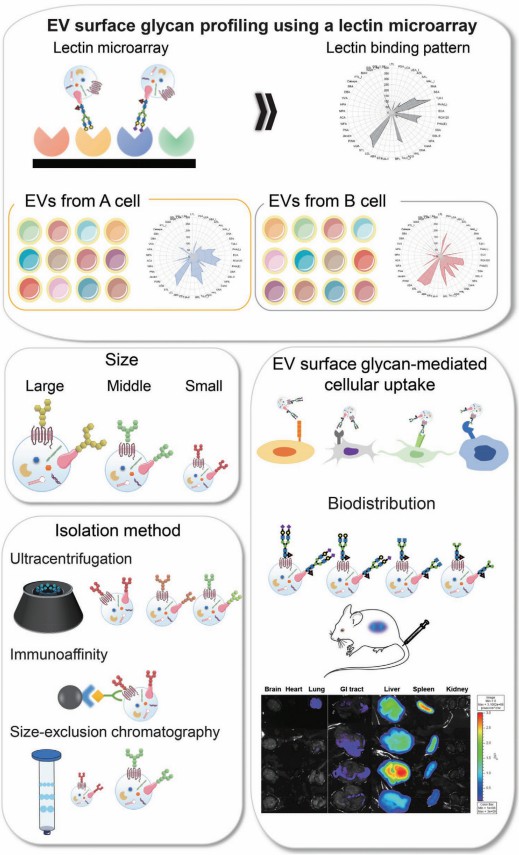Exosome Distribution Summary
Exosomes are derived from natural cells and disease cells and have the properties of stable cargo encapsulation and modifiability, making them welcomed as effective therapeutic carriers of genes and drugs. Their biological properties, such as tissue distribution and enrichment in tumors, are profoundly informative for the subsequent exploration of their therapeutic effects and potential toxicity. Creative Biolabs has accumulated insights into exosome distribution and offers research services including the development and functional exploration of exosome-based delivery systems.
Exosome Distribution in Normal Tissues
Exosome tissue distribution resembles that of other nanovesicles and is influenced by exosome particle size, surface charge, and lipid bilayer composition. The liver, lungs, and spleen receive the majority of unaltered exosomes after intravenous administration. In addition to their intrinsic properties, endogenous exosomes that are naturally present in circulation also have an effect on how exogenous exosomes are distributed in the future. For instance, a study using exosomes from peripheral blood injection inhibited the hepatic accumulation of later-injected exosomes from grapefruit. While the lungs and malignancies became the new target tissues for grapefruit-derived exosomes. This came about as a result of endogenous exosomes playing a competitive function in hepatic exosome clearance by inhibiting the uptake of exogenous exosomes by macrophages by activating the CD36-mediated pathway. The tissue location of exosomes following circulation is also altered by the exosome dose supplied. Lower concentrations of exosomes are mostly dispersed in the liver and spleen, but higher doses of exosomes cause considerable pulmonary deposition.
Exosome Distribution in Tumors
EPR effect is present in tumor exosome distribution. Exosomes are specifically retained in the tumor site once they have entered because of the tumor's abnormally fast rate of growth compared to surrounding healthy tissue, its vascular endothelial cells' poor arrangement and permeability, its lack of internal lymphatic drainage, and its slow rate of blood flow. The specific chemicals exposed on the exosomal surface have an impact on the exosomes' propensity for distribution in tumors. One of the mechanisms determining the organotropism of exosomes, including integrins α6β4 and α6β1 related to lung metastasis and integrin αvβ5 associated with liver metastasis, is the expression pattern of integrins on the exosome surface. However, the variety of exosomal surface glycans also influences the tissue distribution and cellular targeting of these molecules. Through a threefold interaction with their ligand CCL18 after CCR8 bridging, glycosaminoglycans exposed on glioma exosomes direct exosome targeting to CCR8-positive glioblastoma cells. The impact of exosome surface glycan alteration on exosome uptake and distribution has been identified in another investigation. Exosomes' homotactic properties offer a further way to use tumor cells to produce exosomes that can be used to target homotypic tumors. A mildly acidic TME enhances exosome enrichment in tumors, demonstrating that the physiological properties of the TME (tumor microenvironment) have a non-negligible impact on exosome distribution. The high concentration of sphingomyelin/ganglioside GM3 (N-acetyl neuraminic-galactosyl glucosylceramide) on the exosome membrane, which undergoes a positive charge change in the acidic environment compared to the original negative charge in the physiological environment, is thought to be responsible for this enhanced distribution effect. This allows for better fusion and uptake with negatively charged cell membranes.
 Fig.1 The role of EV surface glycans in EV heterogeneity and cell–EV interactions. (Shimoda, 2022)
Fig.1 The role of EV surface glycans in EV heterogeneity and cell–EV interactions. (Shimoda, 2022)
The tissue distribution and tumor targeting of natural exosomes have been shown to be influenced by the exosome membrane components and the display of specific molecules on its surface, as well as the abnormal tumor microenvironment characteristics of acidity, providing a reference for the comprehension of the effect of exosomes as stable delivery vehicles. Creative Biolabs has accumulated insights into the application of exosomes to precise tissue distribution and targeted drug delivery, providing comprehensive exosome research services. Please feel free to contact us.
Reference
-
Shimoda, A.; et al. Assessment of surface glycan diversity on extracellular vesicles by lectin microarray and glycoengineering strategies for drug delivery applications. Small Methods. 2022, 6(2): e2100785.
For Research Use Only. Cannot be used by patients.
Related Services:

 Fig.1 The role of EV surface glycans in EV heterogeneity and cell–EV interactions. (Shimoda, 2022)
Fig.1 The role of EV surface glycans in EV heterogeneity and cell–EV interactions. (Shimoda, 2022)









